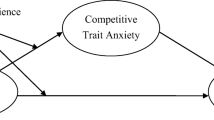Abstract
Initial evidence suggests that the employment of self-handicapping strategies has a beneficial effect on negative affective states associated with the perceived threat of evaluative contexts (Harris & Snyder, 1986; Leary, 1986). The present study sought to describe the type of self-handicapping behaviors demonstrated by youth athletes (N=238) as well as to assess the stress-buffering role of athlete self-handicapping on indices of competitive state anxiety. Specifically, it was hypothesized that among high trait-handicapping athletes, those who report a greater degree of performance-debilitating obstacles prior to competition would demonstrate lowered cognitive and somatic state anxiety as well as greater state self-confidence than nonhandicapping athletes. However, MANOVA results indicated that both high trait and situational self-handicappers demonstrate elevated state anxiety immediately prior to competition. Results are discussed in relation to the possible role of state anxiety as a salient self-handicapping strategy within competitive sport.
Similar content being viewed by others
References
Ansbacher, H.L. & Ansbacher, R.R. (1967). The Individual Psychology of Alfred Adler. New York: Harper and Row.
Arkin, R. M., & Baumgardner, A. H. (1985). The facultative effects of providing a handicap. Unpublished manuscript, University of Missouri, Columbia.
Berne, E. (1964). Games people play. New York: Grove Press.
Carron, A. V., Prapavessis, H., & Grove, J. R. (1994). Group effects and self-handicapping. Journal of Sport and Exercise Psychology, 16, 246–257.
Cassel, J. (1974). Psychosocial processes and “stress”: Theoretical formulations. International Journal of Health Services, 4, 471–482.
Cohen, S., & Wills, T. A. (1985). Stress, social support, and the buffering hypothesis. Psychological Bulletin, 98, 310–357.
Cronbach, L. J. (1951). Coefficient alpha and internal structure of tests. Psychometrika, 16, 297–333.
Greenberg, J., Pyszczynski, T., & Paisley, C. (1985). Effect of extrinsic incentives on the use of test anxiety as an anticipatory attributional defense: Playing it cool when the stakes are high. Journal of Personality and Social Psychology, 47, 1136–1145.
Harris, R.N. & Snyder, C.R. (1986). The role of uncertain self-esteem in self-handicapping. Journal of Personality and Social Psychology, 51, 451–458.
Hausenblas, H. A., & Carron, A. V. (1996). Group cohesion and self-handicapping in female and male athletes. Journal of Sport and Exercise Psychology, 18, 132–143.
Higgins, R. L., & Snyder, C. R. (1989). Excuses gone awry: An analysis of self-defeating excuses. In R. L. Curtis (Ed.), Self-defeating behaviors: Experimental research, clinical impressions, and practical implications (pp. 99–130). New York: Plenum.
Jones, E. E., & Berglas, S. (1978). Control of attributions about the self through self-handicapping strategies: The appeal of alcohol and the role of underachievement. Personality and Social Psychology Bulletin, 4, 200–206.
Jones, E. E., & Rhodewalt, F. (1982). The Self-handicapping Scale. (Available from F. Rhodewalt at the Department of Psychology, University of Utah, Salt Lake City, UT 84112.)
Kelley, H. H. (1972). Attribution in social interaction. Morristown, NJ: General Learning Press.
Kline, P. (1986). A handbook for test construction: Introduction to psychometric design. London, N.Y.: Methven and Co. Ltd.
Leary, M. R. (1986). The impact of interactional impediments on social anxiety and self-presentation. Journal of Experimental Social Psychology, 22, 122–135.
Martens, R. (1977). Sport Competition Anxiety Test. Champaign, 111: Human Kinetics.
Martens, R., Burton, D., Vealey, R. S., Bump, L. A., & Smith, D. E. (1990). Development and validation of the Competitive State Anxiety Inventory-2. In R. Martens, R. S. Vealey, and D. Burton (Eds.), Competitive Anxiety in Sport. Champaign, 111: Human Kinetics.
Rhodewalt, F. (1984). Self-handicapping scale: Convergent and discriminant validity. Unpublished data. Available from the author at the Department of Psychology, University of Utah, Salt Lake City, UT 84112.
Rhodewalt, F. (1990). Self-handicappers: Individual differences in the preference for anticipatory, self-protective acts. In R.L. Higgins, C.R. Snyder, & S. Berglas (Eds.), Self-handicapping: The paradox that isn't. New York: Plenum Press.
Rhodewalt, F., Saltzman, A. T., & Wittmer, J. (1984). Self-handicapping among competitive athletes: The role of practice in self-esteem protection. Basic and Applied Social Psychology, 5, 197–209.
Ryska, T. A., Yin, Z., & Boyd, M. (1997). Athlete self-handicapping: Individual and team motivational correlates in competitive youth sport. Journal of Sport and Exercise Psychology, 16 (Supplement), A-24.
Self, E. A. (1990). Situational influences on self-handicapping. In C.R. Snyder (Series Ed.) & R.L. Higgins, C.R. Snyder, & S. Berglas (Vol. Eds.), Self-handicapping: The paradox that isn't (pp. 37–68). New York: Plenum Press.
Smith, T. W., Snyder, C. R., & Handelsman, M. M. (1982). On the self-serving function of an academic wooden leg: Test anxiety as a self-handicapping strategy. Journal of Personality and Social Psychology, 42,314–321.
Snyder, C. R.. (1990). Self-handicapping: Processes and sequelae. In C.R. Snyder (Series Ed.) & R.L. Higgins, C.R. Snyder, & S. Berglas (Vol. Eds.), Self-handicapping: The paradox that isn't (pp. 37–68). New York: Plenum Press.
Snyder, C. R., & Smith, T. W. (1982). Symptoms of self-handicapping strategies: The virtues of old wine in a new bottle. In G. Weary & H. L. Mirels (Eds.), Integrations of Clinical and Social Psychology. New York: Oxford University Press.
Snyder, C. R., & Smith, T. W., Augelli, R. W., & Ingram, R. E. (1985). On the self-serving function of social anxiety. Journal of Personality and Social Psychology, 48, 970–980.
Author information
Authors and Affiliations
Rights and permissions
About this article
Cite this article
Ryska, T.A., Yin, Z. & Cooley, D. Effects of trait and situational self-handicapping on competitive anxiety among athletes. Curr Psychol 17, 48–56 (1998). https://doi.org/10.1007/s12144-998-1020-9
Accepted:
Issue Date:
DOI: https://doi.org/10.1007/s12144-998-1020-9




